As Congress pushes to prohibit lead-free requirements on public land, private landowners are leading the way on conservation through bullet selection.
“You can walk your boots off on the public land—and you might see some elk—but where you find them is on the big ranches,” says Terance Eichhorn, Director of Land, Livestock and Conservation for AMB West, the company that operates Arthur Blank’s four ranches south of Livingston, Montana. This is the reality many Montana hunters face, often looking over a fence at hundreds of inaccessible elk, but on the AMB West properties, hunters aren’t locked out—they’re welcomed in and changing the conversation around lead-free hunting in Montana.
Tucked below the rugged Absaroka Range and nearly always within view of the wild bends of the Yellowstone River, AMB West manages cattle, grows hay, and leases land to local producers. The northernmost property, Paradise Valley Ranch (PVR), boasts roughly 1,700 acres of irrigated crops, but a fair portion of that protein-packed alfalfa never reaches the mouths of livestock. Instead, hundreds of elk descend most nights from nearby Antelope Butte to dine on the luxuriant crop.
AMB West has always allowed some level of elk harvest, but in 2020, ranch managers formalized a hunt program. “The leadership at the ranch recognized a need to allow locals to harvest a cow elk, primarily for food security,” says Eichhorn. “Many Montanans rely on game in the deep-freeze to get them through the winter.”
AMB West created a website where hunters could apply and enter a drawing for a cow elk hunt. They also began randomly selecting four Park County residents for a bull hunt and donating another to be auctioned off by Gallatin Valley Land Trust, the non-profit that holds the conservation easement for PVR.
Come elk season, hunters team up with ranch staff and glass the landscape. “Sometimes we catch those elk on the hayfields, but otherwise, it’s a spot-and-stalk deal up on the butte. We might be gone all day,” says Eichhorn. No matter the strategy, AMB West staff help hunters consistently find elk. In the first year, PVR hosted 181 hunters and harvested 141 elk.
Lead in the field leads to poisoned eagles

News of the hunt program spread through the community before eventually reaching Dr. Vincent Slabe in nearby Bozeman. Slabe had recently earned his Ph.D. studying the impacts of lead on raptors, finding that nearly half of bald and golden eagles he sampled across the United States had femur lead concentrations consistent with lead poisoning. He published the findings in the prestigious journal Science.
“The more likely a bird is to scavenge, the more likely it will have high lead concentrations,” says Slabe, who now works as a scientist for The Peregrine Fund. Lead ammunition used for hunting is the primary source. Traveling at a couple thousand feet per second, they fragment into hundreds tiny particles upon impact, sending the toxic metal into meat and organs. A portion of that lead is inevitably left in the field within gut piles, carcasses, and unrecovered animals. All are a critical food source for scavengers.
“The valley bottoms of southwestern Montana provide ideal bald and golden eagle wintering habitat,” says Slabe. The snowpack is often thinner and food more available in the forms of roadkill, livestock afterbirth, and hunter harvest. Plus, private lands sometimes boast elk herds exceeding the population objectives set forth by Montana Fish, Wildlife & Parks, often with supplemental hunting seasons that extend into January and even February.
When Slabe initially met with AMB West staff to discuss lead-free ammunition, he encouraged them to watch gut piles and carcasses with game cameras. “The amount of eagles we were getting was just mind boggling,” says Eichhorn, recounting a time he and Slabe returned to a kill site to install a camera. “Within an hour of that carrion hitting the ground, there’d just be a pile of eagles. Flying over, roosting in the trees above, feeding. Seeing that really got us realizing how important it was to switch over to lead-free.”
Hunters and landowners team up for eagle conservation

The Paradise Valley Ranch began requiring all hunters to use lead-free bullets in 2021. To ease the transition, they partnered with Dr. Slabe who had already launched a lead-free distribution program in Wyoming through the Hunters for Eagle Conservation website. He added a Montana page where hunters could apply for a $20 voucher toward a box of lead-free ammunition or bullets at participating sporting goods stores. The program began in 2022 and has been running since, adding additional sporting goods stores, increasing the voucher to $40, and extending the discount to all Montana hunters while funds last.
Since switching over to lead-free in 2021, AMB West has hosted 1092 hunters and killed 958 elk across the four ranches.
“Lead free bullets are a great tool,” says Eichhorn. “They shoot great. They’re consistent. If you’re having a problem with them, it’s probably not the bullet, it’s probably where you’re putting that bullet.”
AMB’s hunt program may be the largest lead-free effort in Montana, but it’s not the only one accelerating the switch. About 70 miles west of the Paradise Valley Ranch in Sheridan, Montana, the Ruby Habitat Foundation’s Woodson Ranch implemented a lead-free policy in 2017.
Lead-free at “The Ruby”
“In a given year, we’ll have some 2,000 people come out here to recreate,” says Dave Delisi, the Outreach Coordinator at “The Ruby,” as locals call it. Whether visitors come to view wildlife, fish, or hunt, they travel from across the country to bask in the ranch’s solitude.
The property spans about 1,200 acres of valley bottom, with hayfields, grazing cattle, and its namesake river snaking through hulking cottonwoods. Willow thickets and hawthorn surround its numerous springs and ponds, attracting warblers, moose, and an overabundance of white-tailed deer.
“This past year, we had approximately 140 hunters during rifle season,” says Delisi. He says it’s the Ruby’s responsibility to make better decisions about their role in how wildlife scavenge the remains from white-tailed deer hunts. “If you drill down on our mission statement, one of the points is encouraging education and training to broaden the understanding of resource management and responsible management of private lands.”
In 2019, biologists discovered chronic wasting disease in the valley, an always fatal neurological disease affecting deer species. To reduce the spread of the highly transmissible disease, Montana Fish, Wildlife & Parks began allowing extended seasons for white-tailed deer on selected private lands, occasionally including the Ruby. More hunters have meant more lead-free outreach. Most are locals. “I would say 50% of hunters come from within 50 miles and then the other 50% expands out beyond that,” says Delisi.
Upon arrival at the Ruby, every hunter checks in at the ranch, so Delisi spends considerable time with each hunter. “They’ve heard me sing praise for non-lead ammo for a while.” He often pulls out an x-ray of a deer shot with a lead bullet, metal fragments strewn across its abdomen. “A lot of the folks who come here are interested in bringing home meat for their families. They’ve got kids, and lead can really impair your kid’s progress. No parent wants that.”
Landowners in Block Management can continue hunters’ conservation legacy

Granted, not all Montana landowners have the means to coordinate a structured hunt program like those run by AMB West and the Ruby. But they can enroll in Block Management, a cooperative program between landowners and Montana Fish, Wildlife & Parks, allowing hunting access on private lands. Landowners can set rules, including a lead-free requirement, says Justin Kool, Access Bureau Chief at Montana FWP. The only barrier is that some Block Management Areas encompass a patchwork of public land where by law the Montana Game Commission cannot regulate ammunition. Despite that roadblock, the American Prairie Reserve, among others, has built a lead-free requirement into its Block Management hunting access.
But broader change requires awareness, more outreach, and ultimately, more hunters making the switch on their own. This shift isn’t unprecedented: hunters have long adapted their practices for the betterment of wildlife, from supporting habitat conservation efforts to switching to steel shot while waterfowl hunting. Choosing lead-free bullets is yet another step in that legacy.
For Eichhorn, Slabe, and Delisi, that change is already happening—one bullet, one gut pile, and one conversation at a time.
From falcons to condors, canyons to plains: Non-lead movement spans the nation
Featured image by Blair Speed Creative.
Sorry, the comment form is closed at this time.






Michael Hundt
This is excellent. We are struggling with lead in the CA Condors here in Santa Clara Cty CA.
We need help moving forward from lead. This video is a great start.
Thanks
Mike